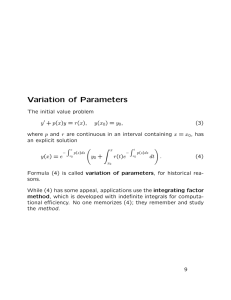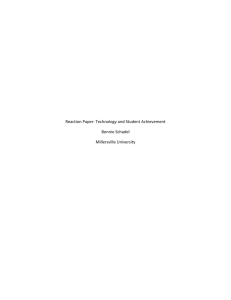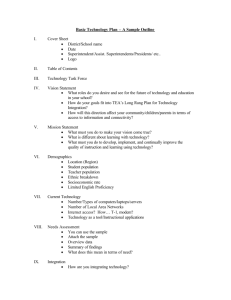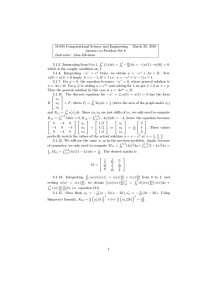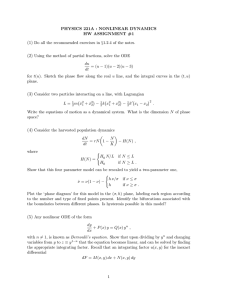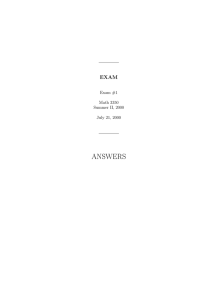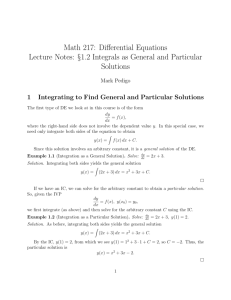2.3 Linear Equations I
advertisement
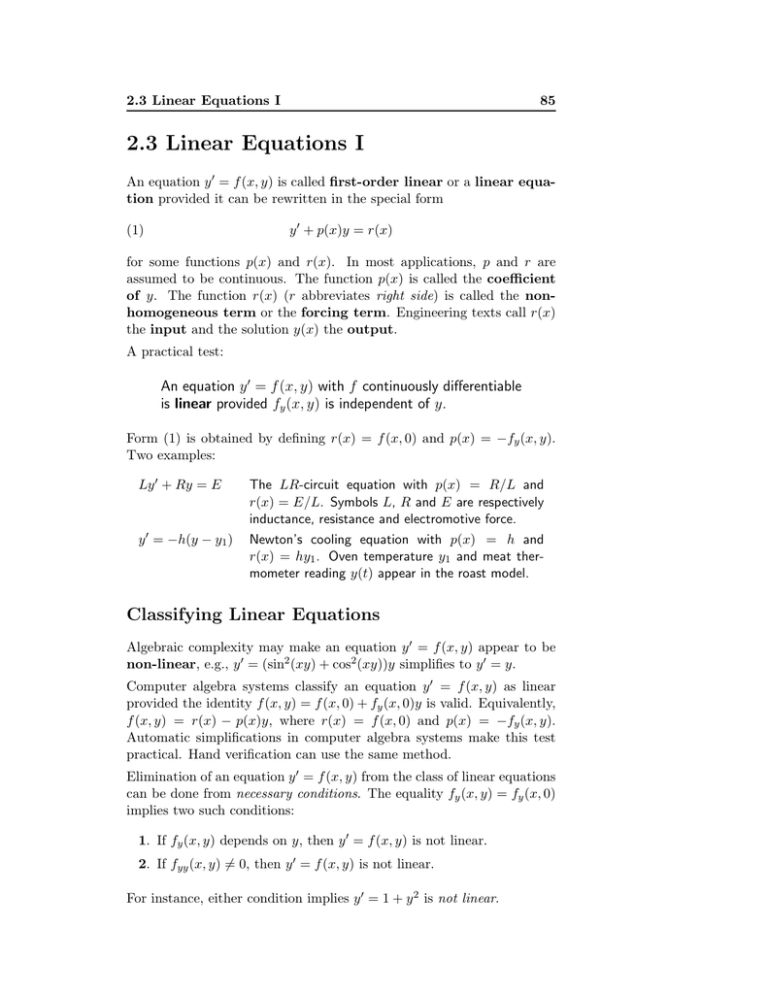
2.3 Linear Equations I 85 2.3 Linear Equations I An equation y 0 = f (x, y) is called first-order linear or a linear equation provided it can be rewritten in the special form y 0 + p(x)y = r(x) (1) for some functions p(x) and r(x). In most applications, p and r are assumed to be continuous. The function p(x) is called the coefficient of y. The function r(x) (r abbreviates right side) is called the nonhomogeneous term or the forcing term. Engineering texts call r(x) the input and the solution y(x) the output. A practical test: An equation y 0 = f (x, y) with f continuously differentiable is linear provided fy (x, y) is independent of y. Form (1) is obtained by defining r(x) = f (x, 0) and p(x) = −fy (x, y). Two examples: Ly 0 + Ry = E y 0 = −h(y − y1 ) The LR-circuit equation with p(x) = R/L and r(x) = E/L. Symbols L, R and E are respectively inductance, resistance and electromotive force. Newton’s cooling equation with p(x) = h and r(x) = hy1 . Oven temperature y1 and meat thermometer reading y(t) appear in the roast model. Classifying Linear Equations Algebraic complexity may make an equation y 0 = f (x, y) appear to be non-linear, e.g., y 0 = (sin2 (xy) + cos2 (xy))y simplifies to y 0 = y. Computer algebra systems classify an equation y 0 = f (x, y) as linear provided the identity f (x, y) = f (x, 0) + fy (x, 0)y is valid. Equivalently, f (x, y) = r(x) − p(x)y, where r(x) = f (x, 0) and p(x) = −fy (x, y). Automatic simplifications in computer algebra systems make this test practical. Hand verification can use the same method. Elimination of an equation y 0 = f (x, y) from the class of linear equations can be done from necessary conditions. The equality fy (x, y) = fy (x, 0) implies two such conditions: 1. If fy (x, y) depends on y, then y 0 = f (x, y) is not linear. 2. If fyy (x, y) 6= 0, then y 0 = f (x, y) is not linear. For instance, either condition implies y 0 = 1 + y 2 is not linear. 86 Variation of Parameters and Integrating Factors The initial value problem y 0 + p(x)y = r(x), (2) y(x0 ) = 0, where p and r are continuous in an interval containing x = x0 , has an explicit solution (justified on page 90) Z x (3) Rt r(t)e y(x) = y0 + x0 p(s)ds dt e − Rx x0 p(s)ds . x0 Formula (3) is called variation of parameters, for historical reasons. While (3) has some appeal, applications use the integrating factor method below, which is developed with indefinite integrals for computational efficiency. No one memorizes (3); they remember and study the method. See Example 11, page 88, for technical details. Integrating Factor Identity The technique called the integrating factor method uses the replacement rule (justified on page 90) (4) Fraction R (Y W )0 replaces Y 0 + p(x)Y, where W = e W The factor W = e R p(x)dx p(x)dx . in (4) is called an integrating factor. The Integrating Factor Method Standard Form Rewrite y 0 = f (x, y) in the form y 0 + p(x)y = r(x) where p, r are continuous. The method applies only in case this is possible. Find W Find a simplified formula for W = e p(x)dx . The anR tiderivative p(x)dx can be chosen conveniently. Prepare for Quadrature Obtain the new equation Method of Quadrature Clear fractions to obtain (yW )0 = RrW . Apply the method of quadrature to get yW = r(x)W (x)dx + C. Divide by W to isolate the explicit solution y(x). R (yW )0 = r by replacing the W 0 left side of y + p(x)y = r(x) by equivalence (4). In identity (4), functions p, Y and YR 0 are assumed continuous with p and Y arbitrary functions. The integral p(x)dx R equals P (x)+C, where P (x) is some anti-derivative of p(x). Because e p(x)dx = eP (x) eC , then factor 2.3 Linear Equations I 87 eC divides out of the fraction in (4). Applications therefore simplify R p(x)dx the integrating factor e to eP (x) , where P (x) is any suitable antiderivative of p(x) (effectively, we take C = 0). Equation (4) is central to the method, because it collapses the two terms y 0 + py into a single term (W y)0 /W ; the method of quadrature applies to (W y)0 = rW . The literature calls the exponential factor W an integrating factor and equivalence (4) a factorization of Y 0 + p(x)Y . Simplifying an integrating factor. Factor W is simplifiedR by dropping constants of integration. To illustrate, if p(x) = 1/x, then p(x)dx = ln |x| + C. The algebra rule eA+B = eA eB implies that W = eC eln |x| = |x|eC = (±eC )x. Let c1 = ±eC . Then W = c1 W1 where W1 = x. The fraction (W y)0 /W reduces to (W1 y)0 /W1 , because c1 cancels. In an application, we choose the simpler expression W1 . The illustration also shows that the exponential in W can sometimes be eliminated. Superposition Formula (3) can be decomposed into two expressions, called yh and yp , so that the general solution is expressed as y = yh + yp . The function yh solves the homogeneous equation y 0 + p(x)y = 0 and yp solves the non-homogeneous equation y 0 + p(x)y = r(x). This observation is called the superposition principle. Equation (3) implies the homogeneous solution yh and a particular solution yp∗ can be defined by (5) − yh = y0 e Rx x0 p(s)ds , yp∗ Rt Z x = r(t)e x0 p(s)ds − dt e Rx x0 p(s)ds . x0 Verification amounts to setting r = 0 in (3) to determine yh . The solution yp∗ depends on the forcing term r(x), but yh does not. Initial conditions of a problem are buried in yh . Experimentalists view the computation of yp∗ as a single experiment in which the state yp∗ is determined by the forcing term r(x) and zero initial data y = 0 at x = x0 . Structure of Solutions Formula (3), proved on page 90, directly establishes existence for the solution to the linear initial value problem (2). The proof also determines what other particular solutions might be used in the formula for a general solution: Theorem 3 (Solution Structure) Assume p(x) and r(x) are continuous on a < x < b and a < x0 < b. Let yh and yp∗ be defined by equation (5). Let y be a solution of y 0 + p(x)y = r(x) on a < x < b. Then y can be decomposed as y = yh +yp∗ , where y0 = y(x0 ). 88 In short, a linear equation has the solution structure homogeneous plus particular. Two solutions of the non-homogeneous equation therefore differ by some solution yh of the homogeneous equation. Examples 11 Example (Integrating Factor Method) Solve 2y 0 + 6y = e−x . Solution: The solution is y = 1 −x 4e + ce−3x . An answer check appears in Example 13. The details: y 0 + 3y = 0.5e−x Divide by 2 to get the standard form. R Find the integrating factor W = e 3dx . W = e3x 0 e3x y = 0.5e−x e3x 0 e3x y = 0.5e2x R e3x y = 0.5 e2x dx 2x Replace the LHS of y 0 + 3y = 0.5e−x by the integrating factor quotient; see page 86. Clear fractions. Prepared for quadrature Method of quadrature applied. −3x y = 0.5 e /2 + c1 e = 41 e−x + ce−3x Evaluate the integral. Divide by W = e3x . Final answer, c = 0.5c1 . 12 Example (Superposition) Find a particular solution of y 0 + 2y = 3ex with fewest terms. Solution: The answer is y = ex . The first step solves the equation using the integrating factor method, giving y = ex + ce−2x ; details below. A particular solution with fewest terms, y = ex , is found by setting c = 0. The solution yp∗ of equation (5) has two terms: yp∗ = ex − e3x0 e−2x . The reason for the extra term is the condition y = 0 at x = 0. The two particular solutions differ by the homogeneous solution y0 e−2x where y0 = e3x0 . Integrating factor method details: y 0 + 2y = 3ex The standard form. W = e2x 0 e2x y = 3ex e3x R e2x y = 3 e3x dx y = e3x + c e−2x Find the integrating factor W = e = ex + ce−2x R 2dx . Integrating factor identity applied to y 0 + 2y = 3ex . Clear fractions and apply quadrature. Evaluate the integral. Isolate y. Solution found. 13 Example (Answer Check) Show the answer check details for 2y 0 + 6y = e−x and candidate solution y = 41 e−x + ce−3x . Solution: Details: 2.3 Linear Equations I 89 LHS = 2y 0 + 6y = 2(− 41 e−x − 3ce−3x ) + 6( 14 e−x + ce−3x ) Left side of the equation 2y 0 + 6y = e−x . Substitute for y. = e−x + 0 Simplify terms. = RHS DE verified. 14 Example (Finding yh and yp ) Find the homogeneous solution yh and a particular solution yp for the equation 2xy 0 + y = 4x2 on x > 0. Solution: The solution by the integrating factor method is y = 0.8x2 + cx−1/2 ; details below. Then yh = cx−1/2 and yp = 0.8x2 give y = yh + yp . The symbol yp stands for any particular solution. It should be free of any arbitrary constants c. Variation of parameters gives a different particular solution yp∗ = 0.8x2 − 5/2 0.8x0 x−1/2 . It differs from the other particular solution 0.8x2 by a homogeneous solution Kx−1/2 . Integrating factor method details: y 0 + 0.5y/x = 2x R W = e0.5 dx/x =e 0.5 ln x = x1/2 0 x1/2 y = 2x x1/2 R x1/2 y = 2 x3/2 dx y = 4x5/2 /5 + c x−1/2 = 4x2 + cx−1/2 Standard form. Divided by 2x. The integrating factor is W = e R p . Simplify the integration constant. Used ln un = n ln u. Simplified W found. Integrating factor identity applied on the left. Clear fractions. Apply quadrature. Evaluate the integral. Divide to isolate y. Solution found. 15 Example (Classification) Classify the equation y 0 = x + ln (xey ) as linear or non-linear. Solution: It’s linear, with standard linear form y 0 + (−1)y = x + ln x. To explain why, the term ln (xey ) on the right expands into ln x + ln ey , which in turn is ln x + y, using logarithm rules. Because ey > 0, then ln(xey ) makes sense for only x > 0. Henceforth, assume x > 0. Computer algebra test f (x, y) = f (x, 0) + fy (x, 0)y. Expected is LHS − RHS = 0 after simplification. This example produced ln ey − y instead of 0, evidence that limitations may exist. assume(x>0): f:=(x,y)->x+ln(x*exp(y)): LHS:=f(x,y): RHS:=f(x,0)+subs(y=0,diff(f(x,y),y))*y: simplify(LHS-RHS); 90 If the test passes, then y 0 = f (x, y) becomes y 0 = f (x, 0) + fy (x, 0)y. This example gives y 0 = x + ln x + y, which converts to the standard linear form y 0 + (−1)y = x + ln x. Details and Proofs Justification of Formula (3): Define Q(x) = e − Rx x0 p(s)ds Z , x R(x) = x0 r(t) dt. Q(t) u 0 0 u The R x calculus0 rule (e ) = u e and the fundamental theorem of calculus result ( x0 G(t)dt) = G(x) can be used to obtain the formulas Q0 = (−p)Q, R0 = r . Q Existence. Equation (3) is y = Q(y0 + R). Existence will be established by showing that y satisfies y 0 +py = r, y(x0 ) = y0 . The initial condition y(x0 ) = y0 follows from Q(x0 ) = 1 and R(x0 ) = 0. The steps below verify y 0 + py = r, completing existence. y 0 = [Q(y0 + R)]0 0 Equation (3), using notation Q and R. 0 = Q (y0 + R) + QR Sum and product rules applied. = −pQ(y0 + R) + QR0 Used Q0 = (−p)Q. = −pQ(y0 + R) + r Used R0 = r/Q. = −py + r Apply y = Q(y0 + R). Uniqueness. It remains to show that the solution given by (3) is the only solution. Start by assuming Y is another, subtract them to obtain u = y − Y . Then u0 + pu = 0, u(x0 ) = 0. To show y ≡ Y , it suffices to show u ≡ 0. According to the integrating factor method, the equation u0 + pu = 0 is equivRx alent to (uW )0 = 0 where W = eP and P(x) = x0 p(t)dt. Integrate (uW )0 = 0 from x0 to x, giving u(x)W (x) = u(x0 )W (x0 ). Since u(x0 ) = 0 and W (x) 6= 0, it follows that u(x) = 0 for all x. This completes the proof. Remarks on Picard’s Theorem. The Picard-Lindelöf theorem, page 62, implies existence-uniqueness, but only on a smaller interval, and furthermore it supplies no practical formula for the solution. Formula (3) is therefore an improvement over the results obtainable from the general theory. Justification of Factorization (4): It is assumed that Y (x) is a given but otherwise arbitrary differentiable function. Equation (4) will be justified in its fraction-free form Z 0 (6) Y eP = (Y 0 + pY ) eP , P(x) = p(x)dx. 0 LHS = Y eP The left side of equation (6). 2.3 Linear Equations I 91 0 = Y 0 eP + eP Y Apply the product rule (uv)0 = u0 v + uv 0 . = Y 0 eP + peP Y = (Y 0 + pY ) eP Use the chain rule (eu )0 = u0 eu and P0 = p. The common factor is eP . = RHS The right hand side of equation (6). Exercises 2.3 Integrating Factor Method. Apply Superposition. Find a particular sothe integrating factor method, page lution with fewest terms. See Example 86, to solve the given linear equation. 12, page 88. See the examples starting on page 88 21. 3y 0 = x for details. 1. y 0 + y = e−x 2. y 0 + y = e−2x 3. 2y 0 + y = e−x 4. 2y 0 + y = e−2x 22. 3y 0 = 2x 23. y 0 + y = 1 24. y 0 + 2y = 2 25. 2y 0 + y = 1 26. 3y 0 + 2y = 1 0 5. 2y + y = 1 6. 3y 0 + 2y = 2 27. y 0 − y = ex 28. y 0 − y = xex 7. 2xy 0 + y = x 29. xy 0 + y = sin x (x > 0) 8. 3xy 0 + y = 3x 30. xy 0 + y = cos x (x > 0) 9. y 0 + 2y = e2x 31. y 0 + y = x − x2 10. 2y 0 + y = 2ex/2 32. y 0 + y = x + x2 11. y 0 + 2y = e−2x General Solution. Find yh and a par- 12. y 0 + 4y = e−4x ticular solution yp . Report the general solution y = yh + yp . See Example 14, page 89. 13. 2y 0 + y = e−x 14. 2y 0 + y = e−2x 33. y 0 + y = 1 34. xy 0 + y = 2 0 15. 4y + y = 1 35. y 0 + y = x 0 16. 4y + 2y = 3 17. 2xy 0 + y = 2x 36. xy 0 + y = 2x 37. y 0 − y = x + 1 18. 3xy 0 + y = 4x 38. xy 0 − y = 2x − 1 19. y 0 + 2y = e−x 39. 2xy 0 + y = 2x2 (x > 0) 20. 2y 0 + y = 2e−x 40. xy 0 + y = 2x2 (x > 0) 92 Classification. Classify as linear or 51. Prove directly without appeal to non-linear. Use the test f (x, y) = f (x, 0) + fy (x, 0)y and a computer algebra system, when available, to check the answer. See Example 15, page 89. 41. y 0 = 1 + 2y 2 42. y 0 = 1 + 2y 3 43. yy 0 = (1 + x) ln ey 44. yy 0 = (1 + x) (ln ey ) 2 45. y 0 sec2 y = 1 + tan2 y 46. y 0 = cos2 (xy) + sin2 (xy) 47. y 0 (1 + y) = xy 48. y 0 = y(1 + y) 49. xy 0 = (x + 1)y − xeln y 50. 2xy 0 = (2x + 1)y − xye− ln y Proofs and Details. Theorem 3 that the difference of two solutions of y 0 + p(x)y = r(x) is a solution of the homogeneous equation y 0 + p(x)y = 0. 52. Prove that yp∗ givenR by equation (5) and yp = Q−1 r(x)Q(x)dx given in the integrating factor method are related by yp = yp∗ +yh for some solution yh of the homogeneous equation. 0 53. Let Q R x= 1 + x and define y = −1 Q e Q(x)dx. Show directly, without appeal to theorems of this section, that y 0 + (1 + x)y = ex . 2 54. Let Q0 = x ln(1 R 2+ x ) and de−1 x Q(x)dx. Show fine y = Q directly, without appeal to theorems of this section, that y 0 + x ln(1 + x2 )y = x2 .
